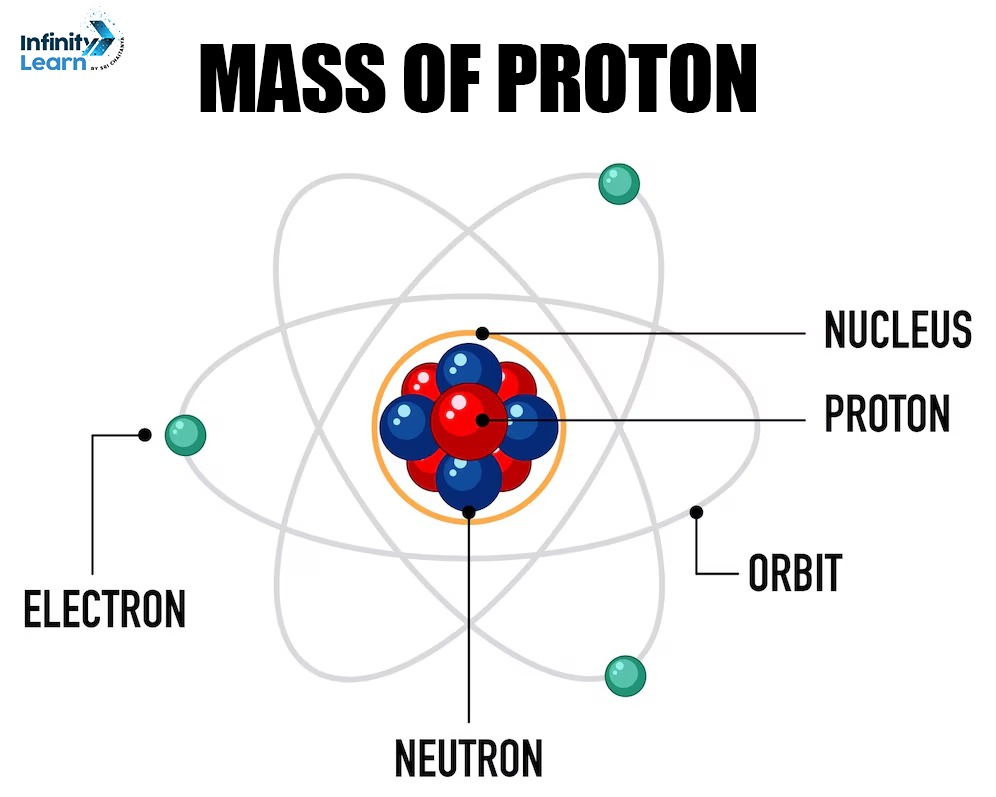Table of Contents
The proton is a subatomic particle with a positive charge and a mass of approximately 1.6726 × 10⁻²⁷ kg. It is one of the fundamental building blocks of atomic nuclei, along with the neutron. The discovery of canal rays, which carry a positive charge, came from experiments with modified cathode ray tubes. These rays behaved oppositely to electrons. The smallest and lightest positive ion, called a proton, was derived from hydrogen. The proton was further characterized in 1919, detailing its unique properties, including its positive charge and mass.
What is Proton?
Protons are positively charged particles located in the nucleus of an atom. An atom is made up of protons, electrons, and neutrons, with its entire mass concentrated in the central nucleus. The nucleus, which houses both protons and neutrons (collectively known as nucleons), is surrounded by electrons that revolve around it in circular orbits.
Mass of Proton Definition
The mass of a proton is the measure of the amount of matter contained in a proton, a positively charged particle found in the nucleus of an atom. The mass of a proton is 1.6726 × 10−27 kg or 1.007276 atomic mass units (amu). This mass is slightly less than that of a neutron, making protons one of the two types of nucleons that contribute to the atomic mass of elements. The mass of a proton plays a crucial role in the calculations of atomic mass and is fundamental to the study of atomic structure and particle physics.

Mass of Proton Units
| Unit | Value |
| Mass of proton in kilograms | mp=1.6726×10−27kg |
| iMass of proton in grams | mp=1.6726×10−24g |
| Mass of proton in Atomic mass unit | 1.00727 amu |
| Mass of proton in MeV | 938.2720813(58) MeV/c2 |
Who Discovered Proton
The discovery of the proton is a remarkable tale of scientific inquiry that has fundamentally transformed our comprehension of the atom and the universe. It began in 1886 with the work of German physicist Eugen Goldstein, who observed positively charged rays in a gas discharge tube. He named these rays “canal rays,” and they were later identified as being composed of protons.
Further advancements were made in 1909 by British physicist Ernest Rutherford through his groundbreaking gold foil experiment. Rutherford’s experiments revealed that the atom’s nucleus was significantly smaller and denser than previously thought. He noticed that some alpha particles fired at the gold foil were deflected at large angles, indicating the presence of a positively charged particle within the nucleus. This particle was subsequently identified as the proton, solidifying its place in atomic theory and expanding our understanding of atomic structure.
The particle in the positive rays in the discharge tube was named a proton. A proton is produced when an electron is removed from a hydrogen atom.
H (hydrogen atom) → H+ (proton) + e– (electron)
Thus, it can be said that a proton is a hydrogen ion (H+).
Properties of Protons
- Mass: The mass of a proton is approximately 1.672×10−24grams or 1.0078 atomic mass units (u).
- Charge: A proton carries an electrical charge of 1.6022×10−19 coulombs (C), which is equal in magnitude but opposite in sign to the charge of an electron.
- Fundamental Nature: The proton is a fundamental particle with a unit mass and a positive unit charge.
FAQs on Mass of Proton
What is the mass of protons?
The mass of a proton is 1.672×10−27 kilograms.
What is the mass of an electron and a proton?
The mass of an electron is 9.109 × 10−31 kilograms, while the mass of a proton is about 1.672 × 10−27 kilograms .
What is the mass of the electron?
The mass of an electron is 9.109 × 10−31 kilograms.
What is the mass of a neutron?
The mass of a neutron is approximately 1.675 × 10−27 kilograms .
Who discovered the proton?
The proton was discovered by Ernest Rutherford in 1917 .
Who discovered electron, proton, and neutron?
The electron was discovered by J.J. Thomson in 1897, the proton by Ernest Rutherford in 1917, and the neutron by James Chadwick in 1932.
Who discovered the proton: Rutherford or Goldstein?
The proton was identified and named by Ernest Rutherford, although Eugen Goldstein had earlier observed positive rays which later were understood to be protons .
Who discovered the neutron?
The neutron was discovered by James Chadwick in 1932 .








